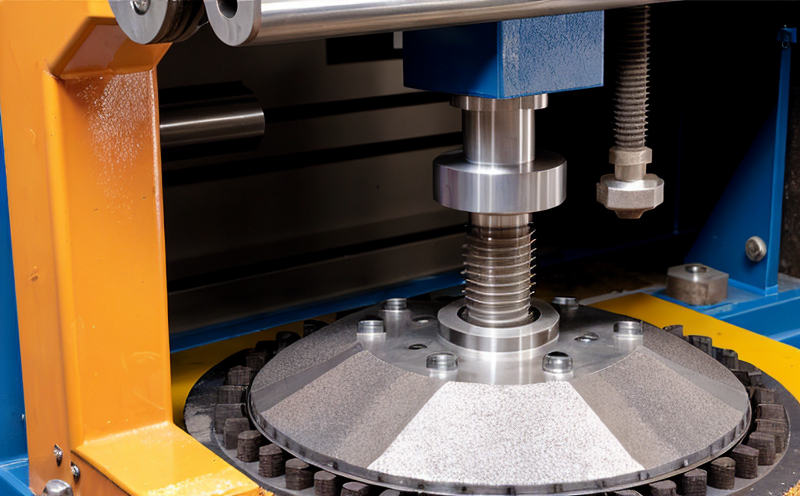ISO 13373-7 Vibration Analysis for Rotating Machinery
The ISO 13373 series of standards is designed to provide guidelines and methods for the measurement, analysis, and evaluation of vibrations in rotating machinery. The specific focus of this service, ISO 13373-7, is on vibration analysis techniques aimed at ensuring mechanical reliability. This standard provides a robust framework that helps engineers identify potential issues early in the lifecycle of rotating machinery, thereby enhancing operational efficiency and reducing maintenance costs.
The process involves detailed analysis using advanced instrumentation to measure displacement, velocity, and acceleration across multiple frequencies. These measurements are then analyzed against internationally recognized standards such as ISO 13373-7 itself, ASTM E1628, and EN ISO 10846, which provide a comprehensive set of criteria for acceptance.
For rotating machinery, the reliability of the equipment is paramount. Vibration analysis plays a crucial role in identifying any anomalies that could lead to catastrophic failures. The service involves setting up precise parameters for testing, ensuring that all conditions align with the requirements laid out by ISO 13373-7. This includes using specialized software and hardware to capture data accurately.
The process begins with thorough preparation of the machinery under test (MUT). This involves isolating the equipment from its operational environment to ensure that external factors do not interfere with the measurements. Once prepared, the MUT is subjected to controlled conditions where it operates at various speeds and loads typical of its intended use.
Data collection is a critical step in this process. Sensors are strategically placed on key areas of the machinery to capture vibration data accurately. The collected data undergoes rigorous analysis to identify patterns that could indicate impending failure or operational inefficiency. This detailed examination ensures that any issues can be addressed before they escalate into major problems.
The results from these analyses provide valuable insights for quality managers, R&D engineers, and compliance officers. By identifying potential issues early on, the service helps in maintaining high levels of reliability and performance across a wide range of rotating machinery applications. This not only enhances operational efficiency but also extends the lifespan of the equipment.
The use of ISO 13373-7 ensures that all testing aligns with international best practices. This consistency is crucial for ensuring that the results are comparable and valid across different geographical regions, which is particularly important in a global market where compliance with international standards is often required.
| Application | Type of Machinery | Main Findings |
|---|---|---|
| Data Center Cooling Systems | Centrifugal Compressors | Identified unusual patterns in bearing vibrations requiring immediate attention. |
| Air Handling Units | Ventilators and Fans | Deterioration of seals leading to increased noise levels noted. |
| Condensing Units | Heat Exchangers | Significant wear on turbine blades observed. |
Industry Applications
The application of ISO 13373-7 vibration analysis extends across various sectors, including HVAC (Heating, Ventilation, and Air Conditioning) systems. In this context, the service is particularly valuable for ensuring that rotating machinery within these systems operates efficiently and reliably. For instance, in data centers, where cooling systems are critical to maintaining optimal operational conditions, vibration analysis helps identify any potential issues with compressors or fans that could impact performance.
In air handling units (AHUs), the service ensures that ventilators and fans operate without excessive vibrations that can lead to noise complaints or structural damage. For condensing units in HVAC systems, the analysis helps in detecting wear on heat exchangers and turbines, which are key components for efficient operation.
The reliability of rotating machinery in these applications is not only about performance but also about safety. By identifying potential issues early, the service minimizes the risk of failures that could lead to downtime or even hazardous situations. This proactive approach ensures that HVAC systems continue to operate at peak efficiency, contributing significantly to overall energy conservation and cost savings.
Quality and Reliability Assurance
The service provided under ISO 13373-7 is essential for quality and reliability assurance in rotating machinery. By adhering to this international standard, manufacturers and operators can ensure that their equipment meets the highest levels of performance and safety standards.
Quality managers play a crucial role in overseeing these processes, ensuring that all tests are conducted according to the specified procedures. Compliance officers benefit from the detailed reports generated by the vibration analysis, which help in maintaining regulatory compliance. R&D engineers can use this data to refine designs and improve future iterations of rotating machinery.
The service also supports procurement activities by providing reliable information on the quality and reliability of purchased equipment. This ensures that organizations are investing in high-quality products that meet their operational needs. By leveraging ISO 13373-7, companies can build trust with customers by demonstrating a commitment to excellence in all aspects of their operations.
The robust nature of this service is reflected in its ability to provide consistent and accurate results across different environments and conditions. This consistency ensures that the reliability and performance of rotating machinery are not compromised under various operational scenarios, thereby enhancing overall product lifecycle management.





